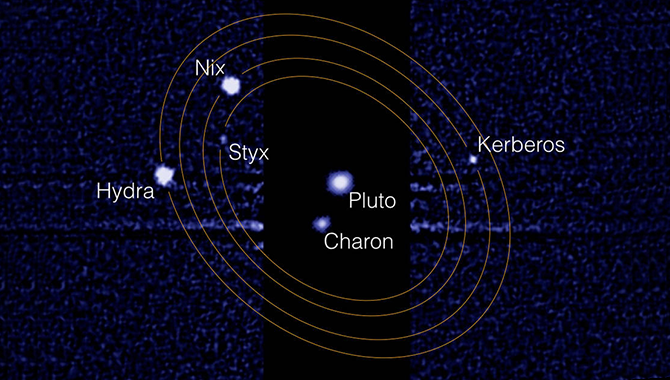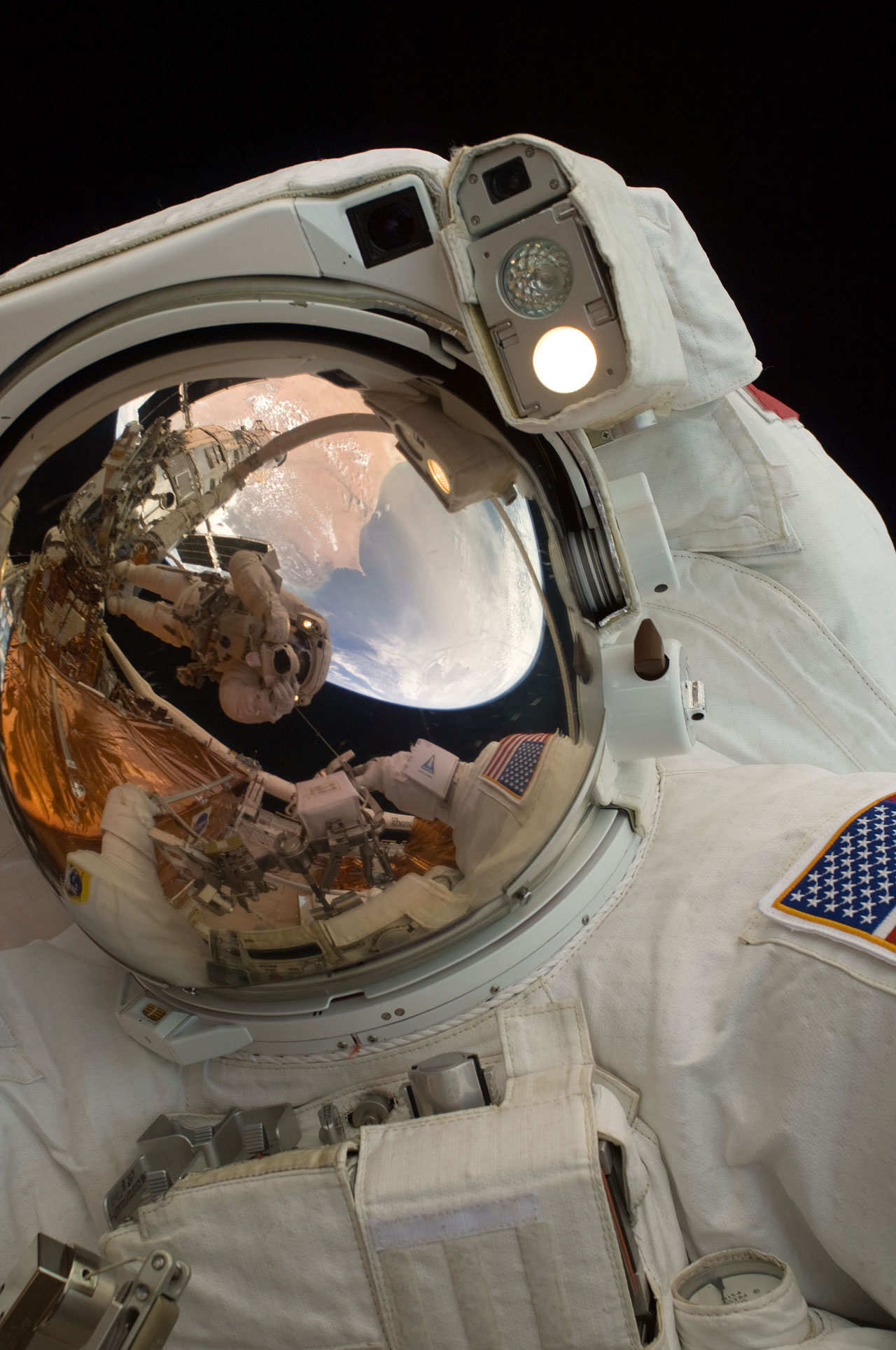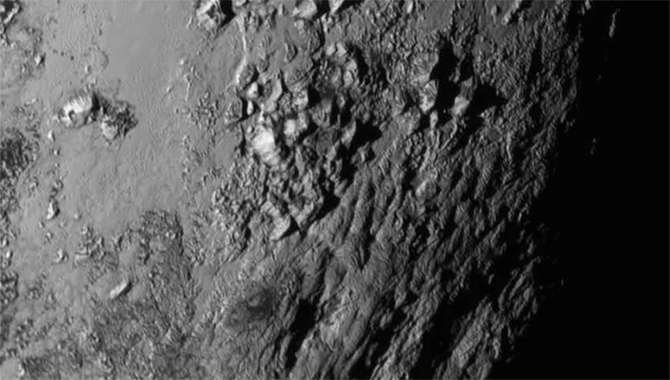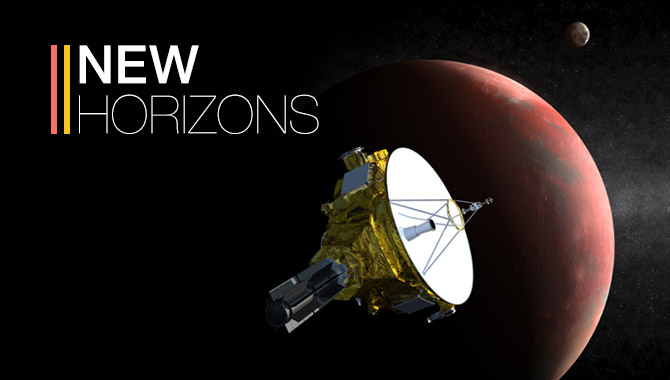
This image portrays the Pluto system as understood today: four smaller moons orbit the binary planet of Pluto and Charon.
Image Credit: NASA/STScl/Showalter
Findings from the Hubble Space Telescope reveal a chaotic environment around Pluto that could endanger the upcoming New Horizons flyby.
New Horizons’ Pluto mission represents a new dynamic in the history of space exploration. “[W]e’re going to Pluto because it’s the human race’s first opportunity to explore an entirely new class of world,” said William McKinnon, New Horizons co-investigator. But any new discovery is fraught with unknowns. A key concern in flying through the Pluto system, as New Horizons will do on July 14, is the danger posed by previously unseen or poorly understood objects, including small moons and minute particles of debris.
Hubble has been an important tool in identifying obstacles to New Horizons’ flyby. Despite recently celebrating 25 years on orbit, the space telescope is still going strong. “With the advanced camera for surveys that we installed on STS-109 in 2002 and the incredible wide-field camera 3 that we installed on STS-125 in 2009, Hubble is much more powerful today than ever. It’s definitely in its prime,” said John Grunsfeld, associate administrator for NASA’s Science Mission Directorate.
Observing the Pluto system from Earth orbit, Hubble has identified two new moons over the past few years. Kerberos, a dark moon discovered by Hubble in 2011, and Styx, a brighter moon discovered in 2012, were added to the list of Pluto moons, which also includes Charon, Nix, and Hydra. Together, Charon and Pluto form a binary planet, locked in orbit around each other. The other four moons orbit the pair. Because the gravitational field around Pluto and Charon changes as they move, the rotations and orbits of Nix, Hydra, Styx, and Kerberos are erratic.
“It is essentially an unpredictable situation,” said Mark Showalter, senior research scientist at the SETI Institute in Mountain View, CA. “This is called chaos.”
“[W]hen we have Charon going by every so often, pulling, changing the orbits slightly, the orbits move in less predictable ways, chaotic ways, and this reduces the stability of the system,” sad Doug Hamilton, professor of astronomy at the University of Maryland, College Park. He explained that three of the moons, Nix, Styx, and Hydra, are in a three-body resonance that helps stabilize the system by preventing all three satellites from lining up simultaneously. Three of Jupiter’s moons, Io, Europa, and Ganymede, behave similarly.
The New Horizons mission, which is rapidly approaching the Pluto system, has benefited from Hubble’s ongoing observations. “The discoveries of these additional moons have made significant changes to some of the New Horizons plans,” said John Spencer, scientist at Southwest Research Institute in Boulder, CO. He pointed out that Styx and Kerberos had not been discovered when the mission developed its initial plans for visiting the Pluto system.
“Because we’re flying through this system at high speed, finding these additional moons was a little bit of a wake up call to the New Horizons project that there might be enough debris in the system that it could cause a threat to the spacecraft,” he said. “Because even a particle the size of a grain of sand, if it hit the spacecraft at the speed that we’re going, could cause damage if it hit the wrong place.”
As a result, the New Horizons team has carefully analyzed the situation to determine what danger, if any, lies ahead. The danger will come not from the moons but from potential debris released by the satellites. The team has several contingency plans, including changes in trajectory or reorienting the spacecraft to use its main antenna dish as a shield. These changes could alter the mission’s ability to capture data about the Pluto system, so the hope is that they will prove unnecessary.
Despite the chaotic nature of the system, the New Horizons team anticipates a swift but smooth transit past Pluto and its moons. “We think it’s unlikely that we will have a problem with a hazard to the spacecraft. We’ll be looking for moons in unexpected places as well as expected places, but right now the dynamics of the system make it likely that we probably won’t have moons that are close enough to the spacecraft to cause us a problem,” confirmed Spencer.
During its flyby on July 14, New Horizons is expected to return groundbreaking data about the Pluto system. “This system is a relic left over from, we believe, the beginning of the solar system. So this is helping us to answer the question of our own origins,” said Grunsfeld.
After it flies by Pluto, the New Horizons spacecraft will continue on toward the Kuiper Belt in the hopes of uncovering answers to more of the mysteries surrounding this region at the edge of our solar system. But observations of the chaotic Pluto system won’t end. “We’ll continue to be able to observe this double planetary system with the Hubble Space Telescope…and, especially, with the James Webb Space Telescope,” said Grunsfeld.
Watch a video showing an artist’s representation of the chaotic transit of Nix around Pluto and Charon.
Read a previous APPEL News article about the New Horizons mission.









